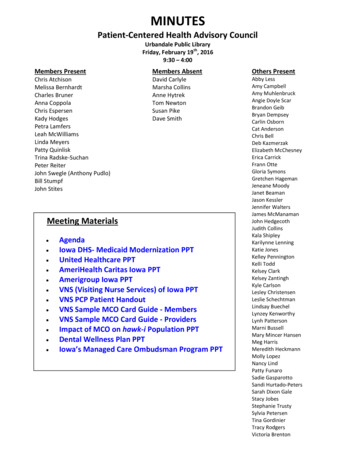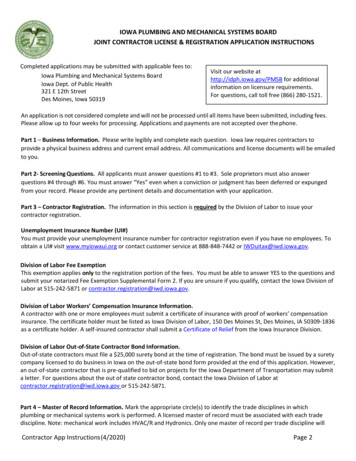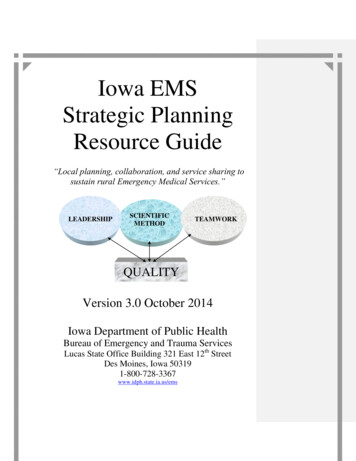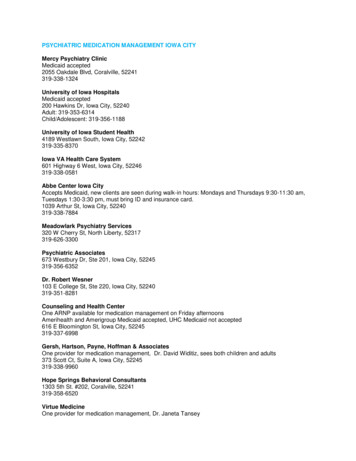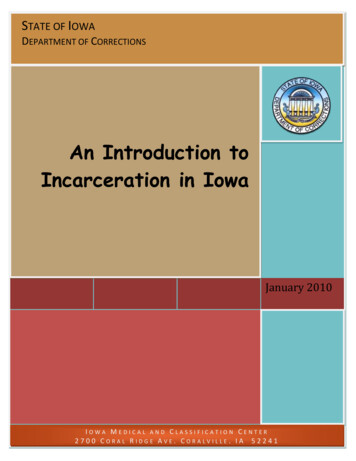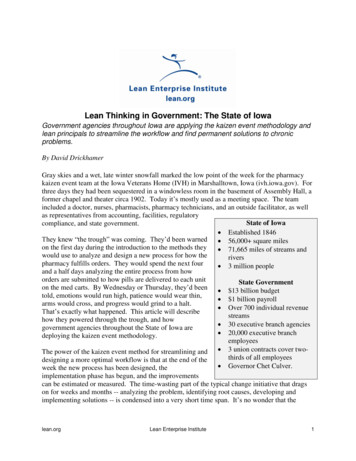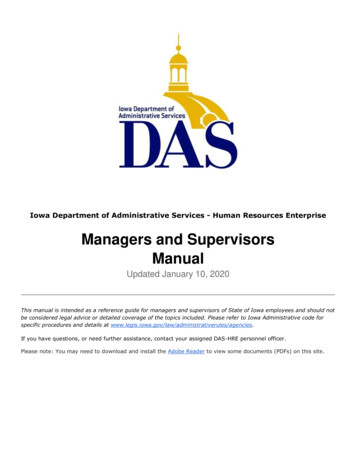
Transcription
Iowa Department of Administrative Services - Human Resources EnterpriseManagers and SupervisorsManualUpdated January 10, 2020This manual is intended as a reference guide for managers and supervisors of State of Iowa employees and should notbe considered legal advice or detailed coverage of the topics included. Please refer to Iowa Administrative code forspecific procedures and details at s.If you have questions, or need further assistance, contact your assigned DAS-HRE personnel officer.Please note: You may need to download and install the Adobe Reader to view some documents (PDFs) on this site.
Table of ContentsEqual Employment Opportunity, Affirmative Action, Sexual Harassment, and Violence-Free Workplace5Equal Employment Opportunity (EEO)5Affirmative Action (AA)5Sexual Harassment5Violence-Free Workplace5Position Classification6The Classification System6Position Description Questionnaires (PDQ)6Position changes7Classification system changes7Pay grade studies7Filling a Vacancy8State worker or contracted temporary worker?8Required paperwork8Announcing the vacancy8After the vacancy announcement closes8Provisional appointment9New Employee Orientation10An overview10Employee information and checklist10Performance & Development Solutions (PDS)11Employee personnel files12General information12Transfer of employee records between departments12Confidentiality of employee information13Public information13Confidential information13Responding to public inquiries about employment-related matters14Requests for information about compensation14Requests for days and hours worked or the use of leave14Summary14Pay administration15General informationReturn to Top15ii
Other pay16Overtime and compensatory time17Special pay18Special pay types requiring DOM and DAS approval20Document processing20Benefits Administration22Types of leave22Other benefits24Performance planning and evaluation29Developing performance expectations29The purpose of performance evaluations29Considering probationary employees30The Performance Planning and Evaluation website30Performance Planning and Evaluation website contents30Employee problems - discussion and referral31Introduction31The Employee Assistance Program31Having a discussion with the problem employee31EAP and discipline31The supervisory referral process32If the impact on the workplace is significant32Follow-up34Confidentiality is vital34Employee Separations and Unemployment Claims35Unauthorized three-day absences35Exit Interviews35Unemployment claims35Claims processing steps36Progressive discipline and just cause38Progressive discipline38Just cause38Peace Officer Bill of Rights39Conducting and documenting a disciplinary investigation39Types of disciplinary actions45Return to Topiii
Grievances47Appeals of disciplinary action48State employee grievance processing steps48Reduction in Force (Layoff)50Preparation for a reduction in force (layoff) - permanent merit-covered employees50Retention Points54Bumping for merit-covered employees55Recall56Promotional outplacement program57Benefits upon layoff and recall57Reduction in force (Layoff) - State Police Officers Council (SPOC)60Bumping for contract SPOC-covered employees64Recall65Temporary layoff66Health and SafetyReturn to Top68iv
Equal Employment Opportunity, Affirmative Action,Sexual Harassment, and Violence-Free WorkplaceEqual Employment Opportunity (EEO)The State of Iowa provides “equal employment opportunity within state government to all persons.” (IowaCode 19B.) This policy ensures individuals are not denied equal access to state employment opportunitiesbecause of their race, creed, color, religion, sex, national origin, age, physical or mental disability, sexualorientation, or gender identity, consistent with applicable state and federal policies and regulations.Affirmative Action (AA)It is also executive branch policy to apply affirmative action measures to correct the underutilization offemales, minorities, and persons with disabilities in state employment system whenever appropriate.The State of Iowa EEO, AA and Anti-Discrimination policies also cover information about: Discriminatory harassment Sexual harassment Violation of the Americans with Disabilities Act of 1990 Complaint Reporting Procedure Assignment of ResponsibilitiesPolicy in full: nts/MS manual/eo aa policy.pdf.Sexual HarassmentThe State of Iowa executive branch is committed to providing a workplace that is free from sexualharassment. State executive branch employees shall not engage in sexual harassment. Sexualharassment is a violation of both federal and state statute. Specifically, harassment on the basis of sex isa violation of Section 703 Title VII of the Civil Rights Act of 1964 (42 U.S.C. Sec. 2000e et seq.) asamended and Iowa Code section 19B.12 and chapter 216. Sexual harassment based on real or perceivedsexual orientation or gender identity is a violation of Iowa Code chapter 216.Allegations of sexual harassment will be taken seriously and prompt investigation will occur. It is thepolicy of the State of Iowa executive branch to maintain the confidentiality of sexual harassmentcomplaints and investigations to the greatest extent possible (see Sections IV and V below for furtherinformation). Complaints and records relating to complaints are confidential and not subject todisclosure under Iowa’s open records laws.Policy in full: nts/MS manual/PolicySexualHarassment.pdf.Violence-Free WorkplaceThe State of Iowa is committed to providing a violence-free workplace for all employees. See the policybelow for more detail. If you have a concern, please talk with your supervisor or personnel officer.Return to Top5
Policy in full: nts/MS manual/PolicyWorkplaceViolence.pdf.Related administrative rules11 IAC 68Equal employment opportunity and affirmative actionAdditional resourcesEqual Employment Opportunity/Affirmative Action – PDS trainingForms referenced in this section552-0318Employee Complaint FormIf you have any questions or need further assistance, please contactYour assigned DAS-HRE personnel officerPosition ClassificationThe Classification SystemThe Classification System provides a structure for human resource management decisions including: Pay range Eligibility for overtime compensation Eligibility for special pay actions (e.g., lead worker pay) Coverage under or exclusion from the merit system provisions of Iowa Code section 8A.411 Coverage under or exemption from the collective bargaining provisions of Iowa Code chapter 20 Selection (minimum qualifications, selective certifications, special requirements, method of fillingpositions, vacancy announcements, etc.)The Classification System consists of more than 800 job classes. Some of these classes are then groupedinto a series - a group of classes that perform the same kind of work. Each job class within a seriesrepresents a different level of work.Job classes are listed in the Classification and Pay Plan, published annually and available electronically inboth alphabetical and class code order. It details pay grades, class codes, and other basic information foreach job class.Position Description Questionnaires (PDQ)A Position Description Questionnaire (PDQ) is a written description of the duties, responsibilities, essentialfunctions, organizational relationships, and applicable selectives and special requirements assigned to aposition. The PDQ allows for identification of the kind and level of work being performed and, as theprimary source of job information, it is critical to the position review process. It also serves as a resourcefor developing vacancy announcements, screening tools, interview questions, and performance plans.More information about completing the PDQ is available at this link: -and-pay/pdqReturn to Top6
Position changesPosition changes take place under a number of circumstances, including the addition/deletion of aposition, position reclassification, cost center change, position type change, bargaining unit change,bargaining status change and merit status change, among others. To initiate any of the above changes, aPosition Change Request (M-5) is initiated and submitted by your designated human resources associate(HRA). The appointing authority and the Department of Management must approve the M-5 prior to theDAS-HRE review. Classification changes may not be retroactively approved.Effective date. Position changes are effective on a date set by DAS-HRE, but will always beeffective at the beginning of a pay period. If the Department of Management does not approve thefunding for a reclassification, duties commensurate with the previous job classification must berestored within three pay periods following that decision. Position changes will not be retroactivelyapproved for an earlier date.Loss of merit system coverage. For reclassifications (and transfers or reassignments) that result inan employee’s loss of merit system coverage, the employee must provide written consent for achange from merit system coverage to non-merit system coverage. If the employee does notconsent to the change, the appointing authority may initiate a reduction in force (RIF).Classification system changesDAS-HRE is responsible for administration of the executive branch classification system, includingreviewing, approving, and implementing any changes. Changes to the Classification System includerevision, creation, or deletion of a job class or series; changes to the pay grade assigned to a job class;and revision, creation, or deletion of a selective certification. Requests for selective certification changesrequire completion of the Request for Selective Certification Additions or Changes Form linked below. Allother requests for changes to the classification system require completion of the Request for Classification,Compensation, and Selection Changes Form linked below. These forms should be submitted to yourassigned personnel officer.Pay grade studiesWhen an agency is having difficulty recruiting/retaining employees for a specific job class, it may be forsalary/pay inequities. Once other causes are ruled out (such as geographic location, organizationalculture, work environment, etc.), pay grade studies may, in some instances, be performed. For requeststo change a pay grade, the Pay Grade Study Questionnaire should be completed. Contact the class andcompensation coordinator for more information regarding pay studies.Related Administrative Rules for this section11 IAC 52Job ClassificationForms referenced in this section552-0697552-0671552-0094552-0709552-0785Job Evaluation QuestionnairePay Grade Study QuestionnairePosition Description QuestionnaireRequest for Classification, Compensation and Selection ChangesRequest for Selective Certification Additions or ChangesIf you have any questions or need further assistance, please contactyour assigned DAS-HRE personnel officerReturn to Top7
Filling a VacancyState worker or contracted temporary worker?When you determine you have a vacant position to be filled, decide if the position needs to be filled with astate worker or if you will use a contracted temp agency. For temporary staffing solutions, go toTemporary Staffing.Required paperworkYou will first need to fill out a Hiring Justification, along with any internal agency documents needed toapprove new hires. This form should be routed to your assigned personnel officer.Next, you will need to fill out the Position Description Questionnaire (PDQ). The form and instructions forcompleting the form are found here. If the duties of the position have not undergone a substantive changeand the previous PDQ was reviewed within the last 24 months, there is no need to submit a new PDQ. Youcan submit the old PDQ with your Hiring Justification. It is always a good idea to review the positiondescription and evaluate if the duties and essential functions are still valid for the position you are filling.Announcing the vacancyAfter the Hiring Justification and PDQ have both been completed and returned to you, your next step is todetermine how your position should be advertised on the state’s applicant tracking system, NEOGOV. Youshould consider the following: Promotional or Open Announcement: Will your vacancy be open only to internal candidates or tothe public?Number of days to post: Ten is the minimum for all postings but there are advantages to postinglonger.Job Description: This should not simply be a restatement of the class description. This is yourchance to describe to your applicants exactly what this position encompasses. Thorough andspecific job descriptions help ensure you attract applicants with the skills and desire to do the job.Additional exposure: HRE’s Statewide Recruiting Coordinator can be reached at (515) 725-2095.The Coordinator can help you find professional organizations, collegiate resources, or otheradvertising venues to assist you in advertising your position to the widest audience possible.Once your decisions have been made, contact your HRA to have your vacancy announcement entered intoNEOGOV. Once entered into NEOGOV, the vacancy will be checked against the recall list and HRAs will benotified if there are any recall candidates. The recall candidate with the highest retention point score mustbe interviewed. Contact your assigned personnel officer if you need assistance calculating the retentionpoint score. If the recall candidate can meet the essential functions of the job, the candidate will be hired.After the vacancy announcement closesOnce the vacancy closes, you will receive a list of referred candidates. You can now proceed with thescreening and interviewing of referred candidates.Return to Top8
Provisional appointmentIf you receive less than six referred candidates, the hiring authority may provisionally appoint a personwho meets the minimum qualifications for the class to fill the position. Contact your assigned personnelofficer for assistance with provisional appointments.Related administrative rules for this section11 IAC 53.5(5)Pay for Interns11 IAC 54Recruitment, Application, and Examination11 IAC 55Eligible Lists11 IAC 56Filling Vacancies11 IAC 53PayRelated resourcesAmericans with Disabilities Act-PDS trainingFrom Interview to Hire: The Successful Search for Talent-PDS trainingDiversity for Managers and Supervisors - PDS training"Unleashing the Power of Diversity" - Diversity Training for Employees - PDS trainingState of Iowa Jobs WebsiteForms referenced in this 775Acknowledgement of Drivers' License RequirementsCDL Supplemental ApplicationHiring JustificationNotice of Conviction for a Violation of a Motor Vehicle LawPersonnel Mobility Assignment AgreementRequest for Reasonable AccommodationRequest for Adaptive Google SoftwareSteps in Filling a VacancyTemporary Staffing Services Vendor RequestBackground Check Policy TemplateParticipation Request Form: Non-Competitive Hiring Program for Disabled VeteransTime Tracking Form: Work Experience/Training Program for Disabled VeteransIf you have any questions or need further assistance, please contactyour assigned DAS-HRE personnel officerReturn to Top9
New Employee OrientationAn overviewNew employee orientation should begin the first week of the employee’s start date. It should include thefollowing: Employee orientation packetso Packets should be available from agencies’ human resources associate, personnel officer, oremployee orientation coordinator. The supervisor should ensure a packet is provided to thenew employee. New employees should be encouraged to ask questions and to contactthe human resources associate, personnel officer, or employeeorientation coordinator for more information. The supervisor, human resources associate, personnel officer, oremployee orientation coordinator will assist completing the requireddocuments. After the documents are completed, submit the packet forprocessing. Review of the written work rules, policies, and procedures. Acknowledgement of receipt of the work rules, policies, and procedures. Explanation of procedures for requesting leave and reporting vacancies, including:o Who to call when absent or late and by what time.o Medical and accident reports required.o Lead time required for requesting vacation (annual leave).o Forms used to request leave. Orientation checklist. Emergency procedures. Information concerning parking, payday, restrooms, food facilities, security procedures, etc. Employees required to operate a motor vehicle as a part of their job must read and sign anAcknowledgment of Driver’s License Requirements form (CFN 552-0564) This form explains thedriver’s license obligations associated with the employee’s job. Supervisors should ensure that employees who are required to operate a motor vehicle as a partof their job or whose positions require possession of a CDL, must complete and sign thenecessary form and acknowledgement CDL Supplemental Application form (CFN 552-0562).Employee information and checklistThe following is an overview to provide supervisors additional guidance about areas that should becovered during new employee orientation. Agencies deliver diverse services to the citizens of Iowa. Theremay be specialized information which need only be presented to employees who work for a particularagency or work unit. Some items included on the New Employee Orientation Checklist may not beapplicable and other items specific to the agency or work unit may need to be added. The New EmployeeOrientation Checklist should be customized to fit the agency or work unit’s needs. Check with your agencyto see if there is a specific form your agency uses. As employees are presented the information, bothsupervisor or designee and employee need to date the appropriate columns in the checklist. This willcreate a permanent record of the orientation progress and contacts for questions that may arise.Questions regarding the appropriateness of information presented during the orientation process shouldbe addressed to the agency’s personnel officer.Sample New Employee Orientation ChecklistReturn to Top10
Performance & Development Solutions (PDS)There are several resources available for managers, supervisors, and employees to increase success onthe job. One is Performance & Development Solutions (PDS). PDS provides organizational development,educational, and training courses for all employees to complement their on-the-job training by providinginformation on principles, procedures, and techniques. Supervisors should discuss and review the PDSservices and course offerings, during the orientation process is a great time to discuss and provideemployees the opportunity to attend suitable courses.The PDS website contains information about PDS programs and services. It also lists scheduled workshopdates offered, course descriptions, and costs.Additional resourcesSample New Employee Orientation ChecklistForms referenced in this chapter552-0564552-0562Acknowledgement of Drivers' License RequirementsCDL Supplemental ApplicationIf you have any questions or need further assistance, please contactyour assigned DAS-HRE personnel officerReturn to Top11
Employee personnel filesGeneral informationThe following documents should be included in the personnel file of each employee in your department.Other documents may also be included according to individual department policy. Performance plans Performance evaluations Disciplinary correspondence Position Description Questionnaires Employee-completed forms concerning benefits, etc. Documents concerning pay, special pay or pay corrections Application Offer of hire/transfer/promotion or other job class or position changes CDL or driver’s license documentation, if required Tax withholding forms Proof of licensure or education, if required Notices of layoff, bumping, recall Military ordersIn accordance with Iowa Code section 91B.1 and the State of Iowa Employee Handbook, an employee shallhave access to and be permitted to obtain a copy of the employee’s personnel file. An employee’s accessto a personnel file is subject to the following: The employer and employee shall agree on the time the employee may have access to theemployee’s personnel file, and a representative of the employer may be present. An employee shall not have access to background checks, applicant information or employmentreferences written for the employee. An employer may charge a reasonable fee for each page of a copy made by the employer for anemployee of an item in the employee’s personnel file not to exceed 5.00. The Code of Iowa definesreasonable fee as an amount equivalent to an amount charged per page for copies made by acommercial copying business.When an employee transfers, promotes, or demotes from one state department to another statedepartment, the personnel records shall be forwarded to the new department.Transfer of employee records between departments11 IAC 4.18 provides for the transfer of personnel records when an employee transfers, promotes, ordemotes. The transfer of personnel records is necessary to ensure continuity to the personnel record of anemployee and to avoid loss of benefits.An appointing authority may, for reasons of operational efficiency, choose to maintain a duplicate set ofrecords. However, originals, or copies if originals are not available, of personnel forms and individualperformance plans and evaluations must be forwarded to the receiving agency, along with copies of theother documents in the employee’s personnel file.Records should be sent through the mail, not given to the employee for transfer.Return to Top12
Confidentiality of employee informationOverviewAs a public employer, the State of Iowa has the duty to keep certain employee information confidential while,at the same time, it must release certain employee information to the public upon request. The followingguidelines should be used when determining whether employee information may be released.House File 291 amended Iowa Code chapter 22, effective February 17, 2017. The information included in thissection supersedes prior communications on this topic, including prior versions of this section andmemoranda issued by the Iowa Department of Administrative Services (formerly Iowa Department ofPersonnel) in December 2000, February 2001, July 2001, and May 2011.Iowa Code chapter 22, known as the Open Records Act, governs the release of information to the public.Iowa Code section 22.2(1) provides that every person shall have the right to examine and copy publicrecords and to publish or otherwise disseminate public records or the information contained therein. Theexemptions to the release of information to the public are enumerated in Iowa Code section 22.7(11):“Personal information in confidential personnel records of government bodies relating to identified oridentifiable individuals who are officials, officers, or employees of the government bodies.”Public informationIn accordance with Iowa Code section 22.7(11)(a), the following information is consideredpublic information and may be released to the public upon written request: The name and compensation of the employee, including any written agreement establishingcompensation or any other terms of employment. Compensation means payment or anagreement to pay any money, thing of value, or financial benefit conferred in return for labor andservices, plus the value of benefits conferred including but not limited to casualty, disability, life,or health insurance, other health or wellness benefits, vacation, holiday, and sick leave,severance payments, retirement benefits, and deferred compensation. The dates the individual was employed by the State. The positions the individual holds or has held while in employ of the State. Educational institutions attended by the employee, including diplomas and degrees earned. The names of previous employers, positions previously held, and the dates of previousemployment. The fact that an employee resigned in lieu of termination, was discharged, or wasdemoted as the result of a disciplinary action, and the documented reasons andrationale for the resignation in lieu of termination, the discharge, or the demotion.Demotion means a change of an employee from a position in a given classification to aposition in a classification having a lower pay grade.In accordance with Iowa Code section 22.15, Personnel records —— discipline —— employeen otification, a government body that takes disciplinary action against an employee that mayresult in information described in section 22.7, subsection 11, paragraph “a”, subparagraph5), being placed in the employee’s personnel record, prior to taking such disciplinary action,shall notify the employee in writing that the information placed in the employee’s personnelfile as a result of the disciplinary action may become a public record.Confidential informationThe following information is considered confidential and may not be released to the public: An employee’s home address, gender, and date of birth.Return to Top13
Individual civil service examination scores. Reasons for utilization of sick leave. Medical or mental health records. Social Security number. Financial institution information. Payroll deductions, voluntary or mandated. Taxable wages (gross wages and other compensation are not confidential).Responding to public inquiries about employment-related mattersIf in doubt as to the agency’s responsibility to disclose information sought by the public, seek advice fromthe agency’s legal counsel and/or the attorney general’s office.Requests for information about compensationInformation about an employee’s total compensation, hourly rate of pay or annual salary is publicinformation and must be released. This includes any special duty pay, extraordinary duty pay, incentivepay tied to performance, recruitment and retention pay, bonuses and other types of compensation.Requests for days and hours worked or the use of leaveThe following information is public record and subject to release: The dates and hours worked. The number of hours of accrued vacation or sick leave. The dates vacation or sick leave was used.If payroll and/or personnel documents are requested, the agency must block out confidential informationprior to release. Social security numbers cannot be released. Information about why an employee usedsick leave is confidential information under section 22.7(11).SummaryThis guidance is not intended to be inclusive of every possible request or situation that may arise.Agencies should seek advice from legal counsel and/or the attorney general’s office if questions ariseabout their obligation to disclose information in response to a public information request.Related Administrative Rules:11 IAC 4.18Agency records11 IAC 62.3Copies of recordsIf you have any questions or need further assistance, please contactyour assigned DAS-HRE personnel officerReturn to Top14
Pay administrationAn employee’s pay must be at least at the minimum and not in excess of the maximum of the pay gradefor the class to which assigned.General informationWithin-grade increasesWithin-grade increases are not automatic, and may be for any amount up to the maximum of the paygrade for the employee’s class.The minimum eligibility period for within-grade pay increases is one year; however, probationaryemployees and employees who receive an increase in base pay as a result of promotion, reclassification,or pay grade change have a minimum eligibility period of six months following the date of the action.The increase can be given any time on or after the employee’s pay increase eligibility date, and must beaccompanied by a current performance rating of at least “meets expectations,” which includes all or a partof the 12 months prior to the increase date. Supervisors must provide the agency’s HRA with a copy of theemployee’s performance evaluation.Pay upon promotionIf an employee is promoted, the employee may be paid at any rate in the pay grade to which theemployee's new class is assigned.Pay upon demotionAn employee who demotes voluntarily or is disciplinarily demoted may be paid at any pay rate in thelower pay grade that does not exceed the employee's pay at the time of demotion.Pay upon transferIf an employee transfers under DAS-HRE rules to the same class or different job in the same pay gradeand pay plan, the employee shall be paid at the employee's current pay rate. If an employee transfers toa class in the same pay grade in a different pay plan and the employee’s current rate of pay exceeds themaximum of the class to which the employee is transferring, the employee shall be paid at the maximumof the pay grade for the new class.Pay upon reclassificationIf an employee's position is reclassified, the employee shall be paid as provided for in the rules onpromotion, demotion, or transfer, whichever is applicable.Pay upon reinstatementWhen an employee is reinstated, the employee shall be paid at the minimum of the pay grade unless anadvanced appointment rate is requested and approved by DAS-HRE prior to offer. Former employees whoretired and applied for retirement benefits under an eligible state retirement system or program are noteligible for reinstatement unless otherwise permitted by law.Pay upon return from leaveIf an employee returns from an authorized leave, the employee shall be paid at the same pay rate as priorto the leave, including any pay increases for which the employee would have been eligible if not on leave.Pay upon recallIf an employee is recalled, the employee shall be paid at the same pay rate as when laid off or b
Jan 10, 2020 · Iowa Department of Administrative Services - Human Resources Enterprise Managers and Supervisors Manual Updated January 10, 2020 This manual is intended as a reference guide for managers and supervisors of State of Iowa employees and should not be considered

